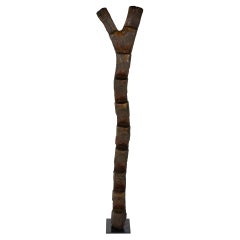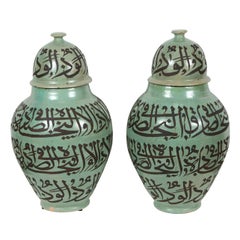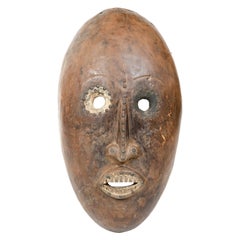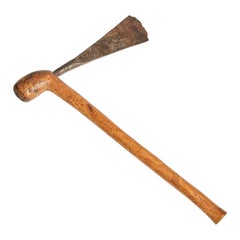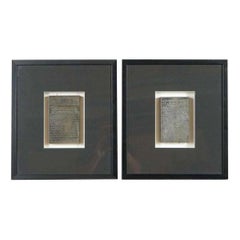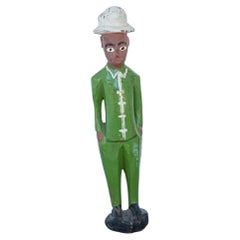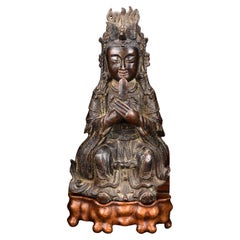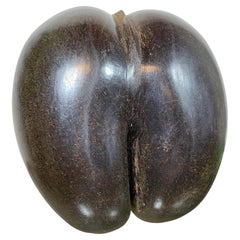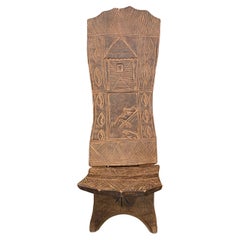African More Asian Art, Objects and Furniture
to
1
8
2
8
2
1
1
7
2
2
1
6
1
1
13,569
1,730
800
679
549
10
10
10
Place of Origin: African
Tribal Ladder for Dogon
Located in Sagaponack, NY
A mounted Dogon ladder carved from a single hardwood log, having nine (9) steps and a split top. Traditionally used by the Dogon (Mali) to access their homes which were built into th...
Category
20th Century African More Asian Art, Objects and Furniture
$6,800
Green Moorish Ceramic Urns with Chiseled Arabic Calligraphy Writing
Located in North Hollywood, CA
Large green Moorish ceramic Urns chiseled with Arabic calligraphy poetry writing.
Handcrafted vases from Fez Morocco etched with Arabic calligraphy.
This kind of Art Writing looks ca...
Category
20th Century Moorish African More Asian Art, Objects and Furniture
Materials
Ceramic
Tribal Mask from Nigeria
Located in Sagaponack, NY
A hand carved Nigerian tribal mask with bent metal and nail head ornamentation
Category
20th Century African More Asian Art, Objects and Furniture
$1,800
Primitive Tribal Axe from Africa
Located in Sagaponack, NY
An expressive hand crafted primitive axe having an elongated wrought blade attached to a finely carved and shaped hardwood handle.
Category
19th Century Antique African More Asian Art, Objects and Furniture
Materials
Wood
Pair of Arabic Writings Framed in Modern Black Frames
Located in Pulborough, GB
We are delighted to offer for sale this pair of Arabic framed frames.
Gorgeous and decorative pair of Arabic frames.
Dimension: W 39 x D 4 x H 44 cm
Please carefully look at...
Category
20th Century Islamic African More Asian Art, Objects and Furniture
Materials
Glass
Statue of Man African Art
Located in Milano, IT
Beautiful painted wood statue from the 50's, belonging to African art.
The statue of a man African art is made entirely of painted wood, depicts a man with...
Category
1950s Arts and Crafts Vintage African More Asian Art, Objects and Furniture
Materials
Wood
$471 Sale Price
20% Off
Middle Eastern Egyptian Inlaid Marquetry Decorative Platter
Located in North Hollywood, CA
Middle Eastern Moorish decorative plate inlaid with mosaic marquetry.
This beautiful wooden plate with elaborate mosaic marquetry inlay is from Cairo, Eg...
Category
Mid-20th Century Moorish African More Asian Art, Objects and Furniture
Materials
Wood
Tribal House Post from Mali
Located in Sagaponack, NY
An African tribal house post bearing a fertility symbol. Natural sun-bleached African hardwood.
Category
21st Century and Contemporary African More Asian Art, Objects and Furniture
Materials
Wood
$18,500
Miniature Dogon Ladder for Dogon Tribe
Located in Sagaponack, NY
A miniature wooden Dogon ladder with seven steps and split top.
Category
20th Century African More Asian Art, Objects and Furniture
Materials
Wood
Headrest from Africa
Located in Sagaponack, NY
An antique carved wood headrest with a metal stretcher.
Category
21st Century and Contemporary African More Asian Art, Objects and Furniture
Materials
Wood
$2,100
Related Items
18th Century Chinese Lacquer Mother of Pearl Inlay Pewter Teapot
Located in Brea, CA
18th century Chinese lacquer mother of pearl inlay pewter teapot, height to handle top 8 inch, floral decoration as expected for age an...
Category
Early 18th Century Chinoiserie Antique African More Asian Art, Objects and Furniture
Materials
Mother-of-Pearl
Bixia Yuanjun Figure of Bronze Dated Ming Dynasty, 1368-1644
Located in London, GB
Bixia Yuanjun figure of bronze dated Ming Dynasty 1368-1644.
Base of hardwood.
Height excluding base 26cm;
Heigh including base 31cm.
Condition:
Corrosion on reverse/back;
...
Category
15th Century and Earlier Ming Antique African More Asian Art, Objects and Furniture
Materials
Bronze
Ovaloid by Ango, Rattan Ceiling Light for 21st Century Lighting Design
By Ango
Located in Bangkok, TH
Rattan pendant light by Ango that explores the magic of natural materials combined with LED lamp technology, the design takes on the form of an extended eclipse. When used in such a ...
Category
21st Century and Contemporary Organic Modern African More Asian Art, Objects and Furniture
Materials
Rattan
$2,043 / item
H 10.5 in W 17.5 in D 63 in
Late 19th-Early 20th Century Chinese Hand Decorated Porcelain Figure
Located in Houston, TX
Late 19th-early 20th century Chinese hand decorated porcelain figure.
Beautifully hand decorated Chinese porcelain figure. This stunning colorful finely detailed figurine or sculptur...
Category
1890s Chinese Export Antique African More Asian Art, Objects and Furniture
Materials
Porcelain
Antique Rare Pottery Coated with Copper Plate Used in Japan/Tsubo Wabisabi
Located in Sammu-shi, Chiba
It is used in Japan.
It seems to be in the Edo period (1700s-1800s).
But details are unknown.
The unique distorted shape is beautiful.
The color and balance of the glaze are al...
Category
Early 19th Century Edo Antique African More Asian Art, Objects and Furniture
Materials
Pottery
$640 Sale Price
54% Off
H 7.09 in Dm 7.49 in
Japanese Antique Pottery with Beautiful Ripped in the Edo Period/Tsubo Wabisabi
Located in Sammu-shi, Chiba
It is an old jar baked in Japan.
It seems to be in the Edo period (1700s-1800s).
The unique distorted shape is beautiful.
The color and balance of the gla...
Category
Early 19th Century Edo Antique African More Asian Art, Objects and Furniture
Materials
Pottery
$900
H 14.38 in Dm 14.97 in
Carved Wooden Traditional Mask from Timor Island, Indonesia, circa 1970s
Located in London, GB
Timor Island sculpted wooden traditional mask (circa 1970s) on contemporary metal stand. This is a traditional mask of a figure with male facial features and two holes as eyes and another for the mouth with a handle below the face. The island of Timor gave rise to a distinctive practice of creating traditional masks whose precise origins and significance remain uncertain. Portraying both male and female ancestors, they were held by men during dances and other ceremonies, including celebrations of victory in war. Carved sculptures and masks are specific to rural villages. Here the practice of animism, or nature-worship, is incorporated with the carving of ancestral statues and masks, which have a ritualistic function. Some occasions that call for these ceremonies may include asking for successful crop planting, for prosperity, for good weather...
Category
1970s Tribal Vintage African More Asian Art, Objects and Furniture
Materials
Wood
$272 Sale Price
20% Off
H 5.52 in W 3.35 in D 1.19 in
Japanese Wabi Sabi Oversized Turned Urn from Solid Block of Wood
Located in Douglas Manor, NY
1390 Japanese Oversized turned hardwood urn.
Category
1940s Vintage African More Asian Art, Objects and Furniture
Materials
Hardwood
Three Églomisé Reverse Painted Snuff Bottles with Magnolia and Orchid
Located in Somis, CA
Our snuff bottles are topped with gemstone grade agate lids and 100% hand painted from within. The Chinese art of églomisé uses a very thin bamboo brush with a few strands of hair to...
Category
2010s African More Asian Art, Objects and Furniture
Materials
Agate
$124 Sale Price / set
54% Off
H 3.5 in W 1.5 in D 1 in
Chinese Bronze Vase with 10 Figures
Located in Los Angeles, CA
Chinese bronze vase with 10 figures - Not certain of age, but works well in any setting and water tight. A very heavy (17 lbs) piece. Beautifully mad...
Category
20th Century African More Asian Art, Objects and Furniture
Materials
Bronze
Auspiciousness Eggs by Ango, the Art&Craft of Feng Shui Egg for Home Decor items
By Ango
Located in Bangkok, TH
Auspiciousness Eggs by Ango is Feng Shui Egg Stone hand-weld and crafted for feng shui home decor items. Kotchakorn Promchai, the renowned Feng Shui master in Thailand invited Ango to create auspiciousness elements to enhance the Feng Shui of a space in a special collaboration. With their sophisticated craft these objects create a beautiful energy around them as well as commanding auspiciousness.
The meaning of Auspiciousness Feng Shui Eggs
Harmony, safety and a smooth path towards achieving goals are overall meaning of Auspicious Feng Shui Egg. The proportion of 52 to 54 mm in length signifies a wealthy life and the width of 42 to 44 mm signifies happiness and prosperity, while the coins placed inside each egg signify good fortune, good luck harmony and spiritual support.
• Silver Auspicious Egg
The colour of peace, justice, intelligence, future-facing, communication, maternity, happiness and prosperity.
• Gold Auspicious Egg
The colour of power, virtue, prestige, leadership, happiness and prosperity.
• Copper Auspicious Egg
The colour of elegance, happiness, charm, popularity, imagination and wealth.
The three colours of Auspiciousness Eggs
The three different colours of Auspiciousness Eggs reflect different aspects in the creation of new energy, happiness and prosperity. Bringing Auspiciousness Eggs into your home or place of work can bring harmony in love, along with good family relations and good fortune in your career, at the same time enabling wealth generation for you, your parents, children and the team who you work with.
The significance of the numbering used in creating the Auspiciousness Eggs
Number 1 signifies success, victory, smoothness in life, leadership and recognition.
Number 6 signifies unexpected fortune, divine blessing, imagination and happiness.
Number 8 signifies wealth, power, popularity and spiritual support.
Number 9 signifies a plenty of propitiousness and auspiciousness.
Each egg is then designed to house 8 silver coins, that are doubled so 16 coins in total; 9 gold coins that are then doubled, so 18 coins; and 10+9 copper coins so 19 coins in total. The technique of doubling is used to increase auspiciousness along with power, and the sequence 8, 9, 10 signifies an increasing power of auspiciousness. So with each piece of Auspiciousness Egg, the propitiousness is maximised in every way and it is recommended you can try one Auspiciousness Egg or one set of three eggs, to gain energy and then build up to 9 elements.
How to place by Auspiciousness Eggs for Feng Shui within your home.
One recommendation is to place the eggs on the desk space or study table. And for stock market investments, it is recommended the eggs are near to the computer. Another suggestion is on the cashier table, by the safe, or on a shelf with the other decorative items.
Who should have Auspiciousness Eggs?
The Auspiciousness Egg is a Feng Shui element that gains in energy starting with the determination patience and meditative skill shown by the artisans who create each piece by hand. This good fortune is for everyone no matter what year...
Category
21st Century and Contemporary Arts and Crafts African More Asian Art, Objects and Furniture
Materials
Steel
$215 / set
H 1.8 in W 5.5 in D 5.5 in
Khmer Bronze Figure of Prajnaparamita with Eleven Faces
Located in Austin, TX
The embodiment of transcendental wisdom, Prajnaparamita is often referred to as the mother of all Buddhas.
In this extremely rare tantric form, she is portrayed seated in the half lotus position. Her eleven faces are arranged in two tiers (seven on the first, with an additional four above), all surmounted by a rising conical chignon. Each face has an associated pair of arms which radiate outwards, each hand holding a discreet attribute.
Careful attention has been paid to her clothing and jewelry. She wears a heavily pleated sampot with a cross hatch pattern, elegantly turned down at the waist and tied with an ornate belt...
Category
18th Century and Earlier Antique African More Asian Art, Objects and Furniture
Materials
Bronze
Previously Available Items
Large Coco De Mer Carved Bowl
Located in Hastings, GB
Fabulous bowl hand crafted from the rare Coco De Mer, a double lobe nut which is found exclusively in the Seychelle Islands, the flowers are borne in enorm...
Category
Early 1900s Folk Art Antique African More Asian Art, Objects and Furniture
Materials
Coconut
Rare Antique African Palaver Chair
Located in New York, NY
Rare antique African hand carved chair. Beautiful patina on the single wood back rest, with multiple motifs. This folding chair is made from a single piece of ébéniste wood from west Africa. Also called guard chair, the palaver chair...
Category
1950s Primitive Vintage African More Asian Art, Objects and Furniture
Materials
Reclaimed Wood, Wood
Rare Antique African Palaver Chair
Located in New York, NY
Rare antique African hand carved chair. Beautiful patina on the single wood back rest, with multiple motifs. This folding chair is made from a single piece of ébéniste wood from west Africa. Also called guard chair, the palaver chair...
Category
1950s Primitive Vintage African More Asian Art, Objects and Furniture
Materials
Reclaimed Wood, Wood
Ancient Egyptian Purple Amethystine Quartz Ointment Vase
Located in London, GB
From the Old Kingdom onwards, many descriptive wall reliefs and paintings can be found depicting the production of various stone vessels . We can infer from these portrayals that the...
Category
15th Century and Earlier Antique African More Asian Art, Objects and Furniture
Materials
Stone
Head of Anubis
Located in London, GB
Anubis the God of Death is among the most iconic gods in ancient Egypt and people during this time knew him as Anpu or Inpu. Anubis is among the oldest deities whose mentioning can b...
Category
15th Century and Earlier Antique African More Asian Art, Objects and Furniture
Materials
Wood
Large Faience Ram
Located in London, GB
Strikingly similar to the Romano-Egyptian Ram currently in the Met this piece depicts a ram, with a highly textured and naturalistically modelled coat, curled horns and a static forw...
Category
15th Century and Earlier Antique African More Asian Art, Objects and Furniture
Materials
Ceramic
The 'Gillot' Taweret
Located in London, GB
This statuette represents the goddess Taweret, an apotropaic goddess, whose domain was the protection of pregnant women and their babies, especially during childbirth. Her threatenin...
Category
15th Century and Earlier Antique African More Asian Art, Objects and Furniture
Materials
Limestone
Ushabti of 'Paser'
Located in London, GB
An Ushabti is a funerary figurine used throughout ancient Egypt, placed in a tomb to aid as a servant to the deceased, conducting manual labour for them...
Category
15th Century and Earlier Antique African More Asian Art, Objects and Furniture
Materials
Limestone
Ushabti of 'Kenj'
Located in London, GB
The XIX Dynasty of Ancient Egypt was part of the Egyptian New Kingdom and was founded by Vizier Ramasses I, whom Pharaoh Horemheb chose as his successor to the throne. The XIX Dynasty is best remembered for its military conquests in the lands of Canaan. The relative peace of the XVIII Dynasty gave way to a century of wars, which produced art that attempted to maintain ancestral traditions in order to claim its dynastic lineage and succession to the throne.This large serpentine statue tells of the prominence of administrative art during this period. The figure is an ushabti, a funerary statue that would have been placed in a tomb among the grave goods of the inhabitant, intended to act as a servant for the deceased in the afterlife. The ushabtis would be called upon to perform their menial tasks, each figure's purpose is often attested to by objects in their hands, such as bread-baker holding grain or farmer holding a scythe, and they would be donated by the workers of the deceased to fulfill their roles for them in death. Hieroglyphics could often also be found running the length of their legs giving further clues to their roles and stating whom they intended to work for. These inscriptions were called answers and asserted the figures readiness to be summoned to the gods work The practice of placing ushabtis inside tombs originated in the Old Kingdom, with the earliest evidence from the middle of the third millennium B.C. when they buried next to mummies[2]. They are normally miniature in size, of hard stones such as limestone, granite or serpentine (and occasionally of faience or bronze), and produced in multiples to provide the important deceased with an army of workers. Sometimes so many were produced that they world cover the entire surface floor of a tomb. Due to this commonness, many extant examples survive, in varying qualities, and as a collection of artifacts they provide a unique insight in to the fascinating death customs of the Ancient Egyptians, highlighting their very real belief in an eternal afterlife.This beautifully carved statue holds hoes and a seed sack, indicating they were destined for manual toil in the eternal afterlife amongst the fields growing grain to produce food for the interred. Another agricultural implement with crisscrossing ropes is tucked in to the back of the figure's kilt, making sure he is ready for any farming situation necessary. He wears a long-sleeved shirt with a long pleated kilt, which has a large over-fold and broad beaded collar. He also wears a double wig composed of zig-zags and echeloned curls, and his face has a slightly aquiline nose, with almond-shaped eyes a fixed, determined gaze.A column running the length of his over-fold contains five lines of hieroglyphic inscription that name the owner of the worker (Kenj), and recite chapter VI from the Ancient Egyptian Book of...
Category
15th Century and Earlier Antique African More Asian Art, Objects and Furniture
Materials
Granite
Cosmetic Duck Vessel
Located in London, GB
This vessel, carved in the form of a wild duck, would have served the purpose of a cosmetic vessel or 'toilet spoon'. Comprised of three individual sections, the head is attached to the base with a collar of bone, and the movable lid is secured by a bone pin...
Category
15th Century and Earlier Antique African More Asian Art, Objects and Furniture
Materials
Wood
Antique African Mahogany Wood Sculptural Side Table or Stool
Located in New York, NY
Impressive antique African mahogany side table or stool, hand carved from a single block of mahogany wood. Great for placing a book or perhaps towels in a bathroom, magazines etc. A ...
Category
Early 20th Century Tribal African More Asian Art, Objects and Furniture
Materials
Wood, Mahogany, Reclaimed Wood
Mahogany Wood African Antique Head Rest or Stool
Located in New York, NY
Traditional antique Lobi tribe head rest hand carved from a single block of mahogany wood with cone style legs. This can be used as a stool or small table to place towels on for exam...
Category
Early 20th Century Tribal African More Asian Art, Objects and Furniture
Materials
Wood, Mahogany, Reclaimed Wood
Recently Viewed
View AllMore Ways To Browse
Jade Mahjong Set
Piha Kaetta
Two Geese
Used King Size Bed Rails
Utility Cart
Verdigris Urn
Verni Martin Display Cabinet
Victorian Oak Dresser
Victorian Walnut Tea Tables
Vintage 2 Piece China Cabinet
Vintage Bone Rings
Vintage Brass Mirrored Tray
Vintage Carnival Posters
Vintage Curio Shelf
Vintage Dessert Trolley
Vintage Fireworks
Vintage Formica Kitchen Table 1960s
Vintage Fresnel Light
